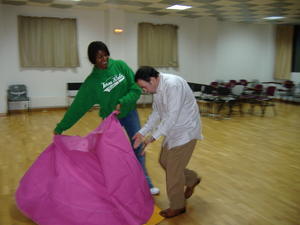Advertisement
Published: November 27th 2006

 Dionne the matador(a)
Dionne the matador(a)
Javier the bull charging Dionne as she practices the Victoria pass.Two weeks ago our fantastically amazing Advanced Grammer & Composition professor, also known as Javier, gave us a special lecture on Tauromaquia, the art of bull fighting. He is an afficianado and wanted us to leave Spain knowing a bit more than we did about this important Spanish tradition.
The lecture started with a bit of history and the importance of bull fighting in Spanish culture. There are two types of bull fighting, rejonaer (when all the matadores are on horseback) and the more widely known type where the matadores are on foot. We learned the parts of the traje de luces (the bullfighters outfit) and that yellow is a bad color and is avoided because of superstition. We also discussed the running of the bulls in Pamplona and the best places to run, if one chooses to run. Javier strongly implored us not to try. The main problem is that their are so many people and if someone in front of you falls or someone behind you pushes you, you are likely to fall and get trampled, first by all the runners and then by the bulls. I assure you I do not plan to run. Watch from a

 Javier in action
Javier in action
Javier with perfect form demonstrating how to hold the smaller cape with the sword concealed behind it.balcony, maybe, run, no. The video game Javier had us try was real enough.
Then, on to bull fighting basics. The simple pass (la victoria) and a few more flashy turns (el serpiente) and others whose names I forget. The hardest part is that you must stand very erect and still and only move the cape. The idea is that the bulls ((are supposed to)) only follow movement: hence the important of standing still and moving the cape. The cape is very heavy and made out of something like a very, very dense canvas. It weighs about 15 pounds and is hard to maneuvar with dexterity. We all agreed that our arms were very tired afterwards. Javier said that many bull fighters also play tenis to keep their arm strength up.
Then, after the cape, the smaller cape with a rod in it is used with the sword concealed behind it. It is crucial to be able to hold the cape with one hand and the sword in the other. I would fail as a bull fighter as I needed both hands to hold up the cape. Javier had good form while we struggled to stand still. It

 Matt the bull
Matt the bull
Tim practicing with the small cape as Matt (as the bull) follows. I thought bulls didn´t laugh.was good that only our classmates were the ´´bulls´´ anything else would have run us over.
And random bullfighting fact. Some festivals start with the ´´drinking bull´´ or drinking cow. A young bull or cow is released into the bull ring and on a raised platform in the center of the ring is a fountain with agua ardiente (a very hard liquor). The crowd is free to drink as much as they want, but the trick is getting up on the platform to reach the fountain. Getting there requires running across the bull ring where there is a wild cow running around. As you can imagine, it is a mad scramble and the cow is nervous and will charge at anything in motion. It is more funny than serious and a chance for wannabe bull fighters to get their machismo out (or get a free drink) before the actual bull fight starts. Sounds fun...
Advertisement
Tot: 0.078s; Tpl: 0.011s; cc: 9; qc: 49; dbt: 0.0489s; 1; m:domysql w:travelblog (10.17.0.13); sld: 1;
; mem: 1.1mb

 Dionne the matador(a)
Dionne the matador(a)
 Javier in action
Javier in action
 Matt the bull
Matt the bull
